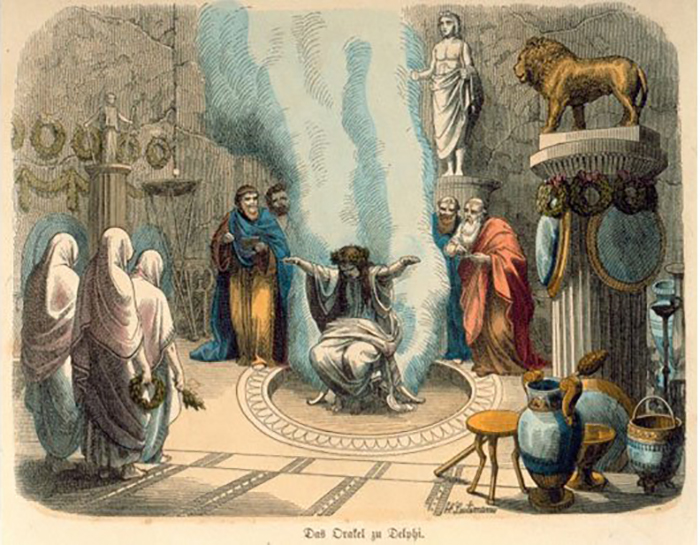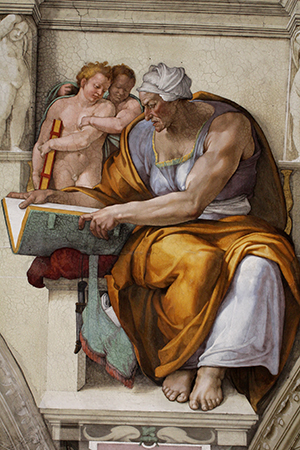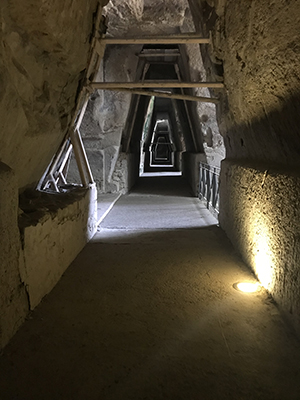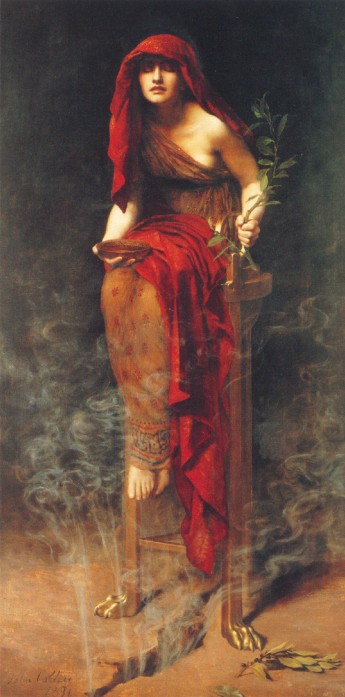The Ancient Oracles : Sibyls, Pythias, and Prophecy
The ancient oracles were the priestesses and mystics that served their community by entering trance states to communicate with the gods and goddesses of Greece and Rome as well as many other regions in the Mediterranean, North Africa, and Southwest Asia. They had many names but often held the titles of “Sibyl” and “Pythia.”
Contact and communication with the divine has been a primary aspect of human spiritual practices from ancient times to the present. The various methods of communication/communion have long been known as divination. The word “divination” is derived from the Latin divinare, “to be inspired by god”, and divinus, “of a god.” Divination is basically the cultural practices of humans that allow us to communicate with the divine and acquire knowledge of the unseen, archetypal, and omnipotent past, present, and future energies that are influencing our daily lives as well as our fate and destiny.
Divination, to the ancients, and to many of us today, is a healing tradition that aligns humans both individually and collectively with the words and will of the sacred forces that intersect our physical realm. Divination is a medicine that comes from what some may know as gods and goddesses or as others may know as the universal currents and unseen spirits of nature and the Otherworld as they exist in dynamic exchange with living matter. The methods of divination have changed, and continue to change, through time. Based on my own research and direct experience I have surmised that, as people became more civilized/human-centered and therefore more disconnected from natural rhythms, they required more complicated and ritualized forms of contacting the spiritual energies of the Earth (otherwise known as Gods and Goddesses).
The transition in Magna Graecia (Southern Italy) from a deep, rhythmic Earthly life embodied by spirit to our modern rational, standardized cosmology where a male divinity resides somewhere else and his words have been frozen and literalized in print, began with the end of the “Civilization of the Goddess” as determined by the great (and controversial) work of renowned archeologist Marija Gimbutas. Gimbutas discovered vast evidence of a pre-pagan society known as “Old Europe” that was matricentered and peaceful with no evidence of war. The corresponding mythos still holds strong threads of powerful feminine forces with the very creation story beginning with the Sky Goddess Ge or Gaia giving birth to the world.
“Ge”, from which the name Gaia is derived, is from ancient Greek meaning “land” or “Earth.” It is from Gaia that all things were made and she was thought to be the deity that communicated with the original oracles. These oracles were living people known as Pythias, Oracles, and Sibyls, often female bodied but not always, that were capable of deep receptivity and trance that allowed them to become a channel for the divine will.
These oracles that once spoke amidst the Greco-Roman landscape belonged to the mythos of Old Europe and the pre-pagan divine feminine where Earth was born from the womb of the Goddess. The modern region of Italy still runs rich and deep with sacred serpentine rivers, blessed mountain sanctuaries of worship, the ruins of dream temples, and caves that reverberate with the ancient prophetic voices old gods. Although the power and agency of feminine forces on Earth and in the Otherworlds has been usurped by first Pagan, and then Christian based patriarchal rule that has it leveled itself upon the dark, volcanic soils of the Mediterranean world, the ritual arts and healing practices of the Goddess culture continue to entwine with the changing culture.
The ancient oracles are thought to have been either fully human or part human/demi-gods. They are often considered to have been female but it’s likely that they were many gendered people with a feminine propensity to be receptive.
Some of the oldest written documentation about the oracles of the Mediterranean came from the divinatory practices of the temple priests and priestesses in Italy, Greece, Mesoptamia, Egypt, and Persia among other possible locations. The oracles were such a prominent part of the culture at this time that Michelangelo painted them on the Sistine Chapel.
Cumaean Sibyl : Sistine Chapel
Delphic Sibyl : Sistine Chapel
Several sources trace the first Oracles to North Africa:
“Some said that this long line of oracles originated in north Africa. A Greek tradition held that the Libyan goddess Lamia gave birth to the first Pythia, fathered by Zeus. Lamia was called "the first woman who chanted oracles, and they say that she was named Sibyl by the Libyans.” [Pausanias, X, xii, in Olmsted, 67] This story accords with other Greek accounts of north African settlements and cultural influence, as well as archaeological finds of archaic Greek vessels with human figurines painted in a Libyan style. The African influence is most dramatically reflected in the tradition that “Black Doves” founded the oracular shrine of Dodona” ~Max Dashu
’For 6,000 years, Africa was ruled by a powerful order of Sibyl matriarchs. They produced the world's first oracles, prophetess and prophets. known as "Pythoness," they worked the oracles in the Black Egyptian colonies in ancient Greece, Rome, Turkey, Israel, Syria and Babylon. Their holy temples were more numerous than the churches of today. In ancient Rome, they first established the "holy seat" of the Vatican advising the world's heads of state. Centuries before Christ, they cured epileptics, the blind, lepers and casted out demons. It was a Sibyl who called-up the spirit of "Apostle" Samuel. Their "pagan" prophecies were used by the emerging Roman papals to create a western theological foundation and became the undisputed precursor for their Christian Bible. African women's religious history is finally being unearthed, exposing shocking revelations buried for more than 2000 years.’ ~From Mama Zogbe: Chief Hounon Mami Wata Vodoun Amengansie Priestess http://mamiwata.com/index8/index12.html
All of the ancient oracles were dedicated to communion with a specific god, goddess, or nature spirit that spoke through them. At Delphi they have been called “Pythias” and were thought to have been in voice of Ge/Gaia and her water serpent or draikana (she-dragon) whose name was “Pytho.” According to the Homeric Hymn to Apollo, Apollo slayed the serpent and took over the oracle who then became the voice of Apollo.
“Many and different are the stories told about Delphoi, and even more son about the oracle of Apollon. For they say that in earliest times the oracular seat belonged to Ge (Earth), who appointed as prophetess at it Daphnis, one of the Nymphai (Nymphs) of the mountains.” ~From Pausanias, Description of Greece
The oracles have also been known as “Sibyls.” Sibyl/Sibyla, according to Greek historian Diodorus Siculus comes from sibyllainein, "to be inspired in one's tongue." The Sibyl’s occupied several locations around the ancient Mediterranean and serving as the voice of the local deity of each place. So for instance, the Sibyl of Cumae was located in the vicinity of the temple of the god Apollo and she was his voice/oracle and those that heard her prophecy heard the words of Apollo himself.
These oracular positions were held for the entire lifetime of the person and were transferred from Sibyl to Sibyl over many generations. It is also thought that in some locations there may have been multiple Sibyls living at the same time and each with the necessary training and skill of prophecy. These oracles were generally located in removed but accessible temples and caves where they lived aesthetic lives devoted to their god or goddess.
The oracles were often consulted by Kings and Emperors usually for information about the strategy and outcome of political strategy, control of power, and war outcomes. They were also consulted by common folks about various matters of love, life, and death. In Book VI Virgil’s epic poem The Aeneid he describes the Greek hero Aeneas seeking the Sibyl of Cumae (modern day Naples, Italy) to guide him into the underworld so he may meet with the spirit of his dead father.
Entrance to the cave of the Sibyl of Cumae.
The hallway that seekers would walk to get to the Sibyl’s cave. It is thought that this walk was part of the process of entering the “womb” or “source” of knowledge.
The cave of Sibyl. Seekers would wait on those benches for her to come out of her cave with her prophecy.
There have been at least 10 known Sibylline oracles:
1. Chaldean (of the line of Noah)
Lycurgus Consulting the Pythia (1835/1845), as imagined by Eugène Delacroix
2. Libyan
3. Delphian
4. Italian
5. Erythrean
6. Samian
7. Cumean
8. Hellespontian
9. Phrygian
10. Tiburtian
"Sibylline Oracles," in Lexham Bible Dictionary (ed. John Barry; Bellingham, WA: Lexham, 2016). Robert C. Kashow
The Oracular Trance
There are several theories about how the oracles were able to commune, channel, and prophesize the words of the divine. Some sources contend that they were simply gifted mediums or psychics. But more commonly, it is believed that they used a substance or substances to induce an altered state.
“Arrived at Cumae, when you view the flood
Of black Avernus, and the sounding wood,
The mad prophetic Sibyl you shall find,
Dark in a cave, and on a rock reclined.
She sings the fates, and, in her frantic fits,
The notes and names, inscrib’d, to leaf commits.
”
The possible trance inducing substances include the volcanic vapors or steam that rose up from fissures between rocks. Archeological excavation has uncovered two geological fault lines beneath the ruins of the temple at Delphi that are formed in such a way that it releases petrochemical (hydrocarbons) vapors that have been identified as methane, ethane, and ethylene. Ethylene, in particular, is considered a “narcotic gas” as determined by the pioneering work of anesthesiologist Isabella Herb who found that a dose of 20% ethylene or less given to patients induced an altered state, euphoria, and trance-like states.
”In the center of the world, a fissure opened from the black depths of Earth, and waters flowed from a spring. The place was called Delphoi (“Womb”). In its cave sanctuary lived a shamanic priestess called the Pythia—Serpent Woman. Her prophetic power came from a she-dragon in the Castalian spring, whose waters had inspirational qualities. She sat on a tripod, breathing vapors that emerged from a deep cleft in the Earth, until she entered trance and prophesied by chanting in verse.
The shrine was sacred to the indigenous Aegean earth goddess. The Greeks called her Ge, and later Gaia. Earth was said to have been the first Delphic priestess. [Pindar, fr. 55; Euripides, Iphigenia in Taurus, 1234-83. This idea of Earth as the original oracle and source of prophecy was widespread. The Eumenides play begins with a Pythia intoning, “First in my prayer I call on Earth, primeval prophetess...” [Harrison, 385] Ancient Greek tradition held that there had once been an oracle of Earth at the Gaeion in Olympia, but it had disappeared by the 2nd century. [Pausanias, 10.5.5; Frazer on Apollodorus, note, 10] “ ~The Pythias; excerpted from Secret History of the Witches by Max Dashu
The Pythia pictured here above a fissure with steam or smoke rising
John Collier: Priestess at Delphi
Another possibility is that they used mind-altering or hallucinogenic plants such as Oleander or Laurel. These were most likely burned and inhaled as smoke. There are some suggestions that they may have taken a type of hallucinogenic preparation made with honey and possibly bee venom. Of course, there is a long history in European shamanism, witchcraft, and prophecy that involves the use of ointments and salves as modes of delivery for hallucinogenic substances.
Many images show the oracle leaning over a tripod with smoke exuding from it.
Other indications strongly suggest that the oracles induced a trance by using snake venom. There is solid evidence of snake worship, snake tending, and divinatory rites that involved live snakes as well as mythical serpents. Many sacred temples and centers of worship housed various species of snakes that were cared for by the priests and priestesses that operated the temples.
“Among the Romans a serpent-cult is mainly connected with the animals as embodying the genius, and snakes were kept in large numbers in temples and houses. The Greek cult of the serpent Asklepios probably influenced the Romans……A more native aspect of the cult is seen in serpent cave Lanuvium, whither virgins were taken yearly to prove their chastity.” ~Encyclopedia of Religion and Ethics
The evidence for the snake venom theory is primarily in the snake imagery found on artifacts from this time period in and around sacred temples. The few written sources that exist point towards the use of cobra or krait snake venom, each of which can produce hallucinations. Also, it is speculated that the ancients knew how to inoculate themselves from the deadly effects of snake bite exposing themselves small amounts of snake venom. This would allow them to be bitten and survive but still receive the hallucinogenic effects of the venom.
This image below is one of the “sleeping giantess” at Bomarzo Park in Viterbo, Italy where we learned her two fingers stretched out as they are symbolized the practice of a snake-bite induced sleep/trance.
Here the same symbol is shown on this statue of Asclepius, the Greek god of medicine.
The practice and art of divination and prophecy in the ancient world happened in every culture on Earth and was a primary aspect of social and spiritual life. The oracles of the Mediterranean were one of many ways that humans sought to communicate with powers beyond their own as well as how they sought to further understand themselves. As the inscription outside of the Temple at Delphi says:
“γνῶθι σεαυτόν
Know Thyself”
For more information on the ancient oracles and the history of the divine feminine in ancient Europe:
Encyclopædia of Religion and Ethics
Max Dashu’s The Suppressed Histories Archives
Civilization of the Goddess by Marija Gimbutas
Descent to the Goddess by Sylvia Brinton Perera
"'I Will Speak . . . with My Whole Person in Ecstasy': Instrumentality and Independence in the Sibylline Oracles." by Olivia Stewart Lester *This is an academic journal article that can be downloaded from the link for free if you put in your email and sign up for an account











